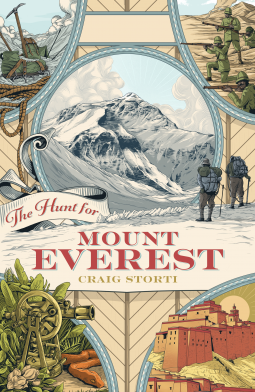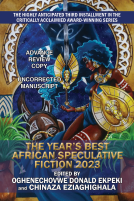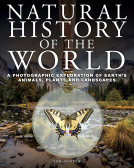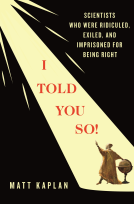
The Hunt for Mount Everest
by Craig Storti
This title was previously available on NetGalley and is now archived.
Send NetGalley books directly to your Kindle or Kindle app
1
To read on a Kindle or Kindle app, please add kindle@netgalley.com as an approved email address to receive files in your Amazon account. Click here for step-by-step instructions.
2
Also find your Kindle email address within your Amazon account, and enter it here.
Pub Date Oct 05 2021 | Archive Date Feb 09 2023
Talking about this book? Use #TheHuntforMountEverest #NetGalley. More hashtag tips!
Description
The height of Mt. Everest was first measured in 1850, but the closest any westerner got to Everest during the next 71 years, until 1921, was 40 miles. The Hunt for Mt. Everest tells the story of the 71-year quest to find the world's highest mountain. It's a tale of high drama, of larger-than-life characters-George Everest, Francis Younghusband, George Mallory, Lord Curzon, Edward Whymper-and a few quiet heroes: Alexander Kellas, the 13th Dalai Lama, Charles Bell.
A story that traverses the Alps, the Himalayas, Nepal and Tibet, the British Empire (especially British India and the Raj), the Anglo-Russian rivalry known as The Great Game, the disastrous First Afghan War, and the phenomenal Survey of India - it is far bigger than simply the tallest mountain in the world. Encountering spies, war, political intrigues, and hundreds of mules, camels, bullocks, yaks, and two zebrules, Craig Storti uncovers the fascinating and still largely overlooked saga of all that led up to that moment in late June of 1921 when two English climbers, George Mallory and Guy Bullock, became the first westerners-and almost certainly the first human beings-to set foot on Mt. Everest and thereby claimed the last remaining major prize in the history of exploration.
With 2021 bringing the 100th anniversary of that year, most Everest chronicles have dealt with the climbing history of the mountain, with all that happened after 1921. The Hunt for Mt. Everest is the seldom-told story of all that happened before.
Available Editions
| EDITION | Hardcover |
| ISBN | 9781529366624 |
| PRICE | $24.95 (USD) |
Average rating from 63 members
Featured Reviews
 Educator 263557
Educator 263557
You may believe Everest was always there, but someone had to find it first. This tells that tale. Fascinating
This history of Mount Everest's early years in the public imagination is nonfiction at its finest!
The average reader may know a little about the 20th/21st century story of Everest... the summit conquered, the lives claimed, the burgeoning waste and crowding problems. A reader may know about George Mallory, one of the first and most famous climbers who lost his life on the mountain in the 1920's. Most histories of Everest would <i>begin</i> with him.
But in a fascinating rewind, this book treats Mallory as the <i>end</i> of the story, a story decades in the making, in which Everest is all but invisible to human eyes.
And it all begins with math. For decades, no Westerner could approach the mountain closer than about 100 miles due to the political restrictions enforced by Nepal and Tibet. And it's so remote that very few Easterners had ever gotten close to it either. From Darjeeling, India, on a clear day, the tip of Mount Everest could be seen, although it looks lower from there than other mountains due to the curvature of the earth. This book describes the Great Trigonometrical Survey of India, a British project that took most of the 19th century to complete.
The calculations that led to the discovery, the frustrating attempts to get closer, the clandestine forays into Tibet, the fights and bloodshed that changed the political landscape, the countless feats of human strength and derring-do, and the humanizing of those early explorers all make for absolutely compelling reading. (I <i>still</i> want to know <i>how close Alexander Kellas got in 1913!</i>) The Googling kept me up late at night.
The book focuses mostly on the all-consuming goal of getting to the mountain, with all the bravery and persistence that required. But it also drops in a few thought-provoking observations about why these men were so driven to reach it. The spirit of exploration ("we climb it because it's there") was at its zenith, but there were some darker philosophies at work too. The author notes that it was "imperial hubris" that supported the British in their attitude that they <i>must</i> be the finders, climbers, and conquerors of the mountain. And one of the most ardent explorers described it as an effort to dispel "the ridiculous idea of the littleness of man." Yes, there's much to think about here.
I could have done with a little condensing of the political context, but this book was well written and gripping throughout. Easily one of the best works of nonfiction I've read!
Standing tall—taller than everything else on the planet—and aloof, there was a mountain, mighty and majestic, unknown to the humans for the best part of their history. It still stands tall—in fact a bit taller than before—but is no longer left alone; besieged by thousands of people willing to risk their lives just to set foot on its summit, Mount Everest is the most famous mountain on earth today. The Hunt for Mount Everest by Craig Storti tells the story of this transformation from obscurity to renown, from the moment when some British surveyors on the hills near Darjeeling in British India trained their theodolites on this blotch on the horizon a hundred-odd miles away, up to the day seventy-one years later when a group of mountaineers and explorers stood at the foot on this colossus.
Situated on the Tibet-Nepal border, Mount Everest was inaccessible to the western explorers—particularly to the British rulers of the neighbouring India—due to political considerations. But that did not deter some enterprising individuals, drawn by the irresistible allure of the mountain, from doing all that was possible to find it, reach it and climb it. The account of these efforts is full of absorbing drama, political intrigue and espionage, wars and treaties, acts of cleverness and foolishness, feats of determination and endurance, and a lot of breath-taking adventure. Spanning across several decades and featuring an eclectic cast of characters—some well-known, like Sir Francis Younghusband, Lord Curzon and George Mallory, and some unsung, like Alexander Kellas, Sir Charles Bell and Guy Bullock—The Hunt for Mount Everest is a magnificent picture set on the immense canvass of the Himalayas.
While much has been written about Mount Everest and the attempts to climb it, beginning with the first attempt in 1921, there is little publicised information about the decades prior to that, and this book fills that void pretty nicely. In addition to telling the Everest story, the author generously touches upon the history of mountaineering itself—beginning with alpine climbing in late eighteenth century—providing a detailed background to the core of this book.
Backed by meticulous research and written in an appealing prose, The Hunt for Mount Everest is an essential read for all those who love mountains, mountaineering and adventure in general. My heartfelt thanks to Craig Storti, Nicholas Brealy Publishing and NetGalley, for the privilege to read and review the e-ARC of this engaging and enlightening work.
Great book with a broad scope
I enjoyed this book. The story about Mount Everest is more complicated than I had imagined. The book explores these complications through a brisk, conversational discussion of the history, geography and politics of the region. This is a much broader scope than I was expecting. I also enjoyed all the biographical information. Overall this book is a great look at the discovery of the great mountain. Thank you to Netgalley and Nicholas Brealey US for the advance reader copy.
I've forever been fascinated by Mt. Everest and the many trips and climbs to reach the highest mountain. This book is just what the Everest enthusiast needs to realize their journey! I really enjoyed it!
Thank you Net Galley for the copy in exchange for my honest review!
 Cary K, Reviewer
Cary K, Reviewer
With the path to the top of Mount Everest now clogged with adventurers waiting their turn to summit, it is hard to believe that it was just 100 years ago when westerners stood for the first time at the base of the great mountain. That 1921 expedition by a small team of British climbers and scientists who trekked for days, along with local porters and pack animals, across the rugged mountains and plains of Tibet to find the fabled Everest, is the subject of Craig Storti's readable, sometimes gripping, well-researched account, "The Hunt for Mount Everest."
As told, the story begins well before the 1921 expedition, and is populated by a cast of daring and larger-than-life mountaineers -- most of whom were Europeans who honed their climbing skills in the much lower altitudes of the Alps. Located on the border between Nepal and Tibet -- countries that were historically inaccessible and politically closed to the outside world -- the existence and location of Everest, and its identity as the world's highest peak, was debated for decades until finally confirmed by Nineteenth Century scientists. Even then, climbers were unable to enter either Nepal or Tibet, and thus unable to hike within sight of Everest, much less attempt to scale the mountain.
Alexander Kellas, one pre-1921 adventurer told of "downed bridges; bottomless crevasses to leap over, go around or even bridge in some cases; seracs that could collapse at any moment; raging torrents to cross; piercing cold winds; all-enveloping mists; waist-deep snowfields taking hours to wade through; snow-blindness; frostbite; headache-inducing sun glare; storms that come on in minutes; the constant risk of avalanches and rock falls; giant ice fields; stubborn and frightened porters who refuse to go on," and more. And all this in some of the "lower" mountains of the Himalayas.
Kellas is one of the book's fascinating characters, but none looms larger than George Mallory, the pre-eminent climber who, as part of the 1921 expedition, was arguably the first Westerner to set foot on Everest -- and whose life subsequently became consumed by the mountain. The aim of the expedition had been not simply to locate and stand upon Everest but to summit the mountain, or at least attempt to identify a path to the top. For a variety of reasons, the team failed in its ultimate goal, but the 1953 conquering of Everest by Edmund Hillary and Sherpa Tenzing Norgay owed much to Mallory and those who came before.
"It must be remembered that they did not know where they were going," Storti writes of the 1921 expeditionary team. The Everest Saga, filled with great risk and adventure and unspeakable tragedy, is as epic and formidable as the mountain itself, and Storti does a wonderful job of telling it.
Thanks to Nicholas Brealey Publishing and NetGalley for the opportunity to read the book in advance of its publication.
I am not a mountaineering or climbing person. I am, though, fascinated by tales of 'discovery' and history in general and finding out about bits I know nothing of.
'Discovery' in quotes because, of course, while this story is about the hunt for "Mt Everest", it's not like the mountain was unknown to the people of Tibet or Nepal or, I imagine, people in China or (what is now) India. And thankfully Storti makes this clear fairly often - that this is discovery only for westerners and, in particular, the British. Storti is under no illusions that some of the things done by the British in both India and Tibet were despicable, and I think he keeps an even hand in explaining the contemporary reasoning (I learned more about "the Great Game" of Britain v Russia in this one book than ever before; the 19th century is so not my period), while simultaneously not excusing or approving of, for instance, sending spies into Tibet when it was explicitly closed to foreigners.
So: the book! The overall point is the discovery that what the British decided to call Mt Everest turns out to be the highest peak in the world. (Yes, there's a section on why it's called Mt Everest, and the fact that didn't even match contemporary expectations of using local names.) There's a digression into the 'discovery' of mountains as beautiful - until the early 19th century they were generally dismissed as being a waste of space and just getting in the way; and also about the development of mountaineering as a hobby, and people climbing in the Alps. Also a whole bit about the great trigonometric survey of India, which was fascinating and absolutely relevant and also bonkers as an undertaking. Within all of that is the colonial attitude towards India, and towards Tibet in particular - the fact that Tibetans didn't want the British within their borders and what some men did in contravention of that (Mr Younghouse, I'm looking at you, arrogant bastard). And eventually, there's the expedition in 1921 that finally means westerners got a look at Mt Everest from close up.
Storti writes a really engaging narrative, explains issues clearly, and balances storytelling with historicity. As someone on the outside of mountaineering I'm unconvinced that George Mallory is more important than Edmund Hillary in the whole Everest saga, but I'll allow him to champion the man now I know a bit more about him (interesting to read about, probably a right pain in the bum to actually spend time with).
This was a really fun book to read (well, fun and sometimes tragic, as is always the case with both mountaineering history and colonial history).
 Joan C, Reviewer
Joan C, Reviewer
I've read many books on expeditions to Everest but none on the discovery or the early explorers and their quest to conquer it. The author excellently outlines the difficulties these men underwent to discover various routes as well as dealing with the Tibetan authorities. First part focuses on the discovery of the peak and then leads on to the planning of the first expedition. A fantastic read and definitely to be recommended to anyone who loves alpine climbing.
I loved reading this book, though I could not speed through it like I would normally. Often, I found myself pausing and thinking about these mountaineering men, the feats they achieved, the way the Raj, India, the British, the locals worked on a daily basis and how things that happened even as long as a century ago added little by little to the bagging of Everest.
I loved Craig Storti's dry wit and wisdom in presenting the hunt and the hunters for Everest, and all the underlying political and geographical intricacies with Nepal and Tibet and its rulers. Storti did a marvellous research and was able to weave a lot of his findings into the story - without making it quotation-heavy or broken. Still, having the participants speak for themselves allowed us, readers, a wonderful insight into the minds of these extraordinary (or, sometimes, extraordinarily petty) people.
An absolutely enjoyable account.
A fascinating book, exploring the history surrounding British attempts to locate and conquer the world's highest mountain. For many years, Everest was undiscovered and inaccessible, mainly due to the known access being via Tibet, a country that was reluctant to allow entry to the British.
The stubbornness and determination of a number of individuals finally led to permission being granted for an expedition in 1921, among the members of which was George Mallory who disappeared near the summit three years later. Mallory was a natural climber, a charismatic and driven man - he and Guy Bullock were possibly the first Westerners to set foot on the mountain. Although the route to the summit was initially missed due to a misunderstanding of local geology, this was later corrected by another member of the party, but the harsh winds on the upper slopes prevented an attempt on the summit at that time.
The mountain was finally conquered in 1953, news of the feat reaching London on the eve of the coronation of Queen Elizabeth II.
Craig Storti lays out in great detail the diplomacy - sometimes chaotic, but never dull - that led to the 1921 expedition, and the characters who came together to make the first foray into the Himalayas that revealed the majestic splendour of Everest, recalled in evocative prose by Mallory. Tibet emerges as a country full of natural wonders, but also difficult weather conditions that proved almost as much of a challenge as the mountains.
There were names here I had never heard of but became fascinated by, not least Alexander Kellas, a Scottish chemist and ardent mountaineer, who sadly died on the 1921 expedition.
There weren't any photographs to enhance the visual aspect, but these may have been left out of the ARC. The maps at the beginning were useful and I liked the use of quotations before each of the chapters.
I was sent an advance review copy of this book by Nicholas Brealey US, in return for an honest appraisal.
What an excellent read! So well-written! I could not put this down. This was a fascinating insight into the evolution of the myth of Everest, into its entry into popular consciousness, and the history of the first westerners on the mountain. I enjoyed very much the details about the mountaineers themselves, as well as the political events that led up to the first exploration (by westerners). I spent a lot of time after I put the book down trying to find out more about what happened to these larger-than-life humans after 1921 (Mallory 🥺💔), and about the mountain that has so captured our imagination. I mean, I want to summit Everest too, just as soon as there's a cable car or teleportation to the top ♡
Highly recommend!
 Media/Journalist 207544
Media/Journalist 207544
Appearing a hundred years after two British men became the first Westerners to set foot on Mount Everest, Craig Storti’s The Hunt for Mount Everest offers a rich and colorful history of earlier attempts to understand, assess and reach the fabled pinnacle. The characters and episodes he chronicles are dramatic enough to fill several novels, while his professional background in intercultural communication helps ground his depictions in a nuanced understanding of the always complex and sometimes destructive ways in which Western ambitions intersected with non-Western lands and cultures. A wonderfully rich, dramatic, and thought-provoking read.
 Reviewer 802375
Reviewer 802375
I never thought before of all the events that led to summiting Everest. All I knew was how in 1953 two men reached the top of the world, so I was happy to read more about the history that surrounds Mount Everest from the moment people measured it to the moment they tried to climb it in 1921. I recommend this book to anyone who is interested in mountaineering and history as well.
 Anne-Marie W, Media/Journalist
Anne-Marie W, Media/Journalist
When Everest was first measured in 1850 and found to be the highest mountain in the world, the westerners became obsessed with conquering it by climbing to the top. They quickly discovered that this was not going to be straight forward for a number of reasons. First they had to convince the Nepalese and the Tibetans to let them into their countries so they could actually access the mountain that straddled these countries. Understandably due to the British obsession with conquering countries for their empires, these countries were not going to just roll over and let the British march in. Second, they had to calculate if human beings could actually survive at the altitude of Everest. Third they had to establish a route to take. Fourth they had to develop the expertise to climb the mountain as they quickly discovered that the Alps they had been used to climbing were like little hills compared to the Andes. Fifth they needed to calculate what supplies they would need for the journey and how to get those supplies up the biggest mountain in the world. These were just the practicalities. There were political implications too. In fact the story of how Mallory and Bullock even got to step foot on Everest is a long, complex and utterly fascinating one. I really enjoyed this because it was so different from all the other books on Everest. I learned so much about the history, politics and even the geography of Everest. Brilliant.
 Dan O, Bookseller
Dan O, Bookseller
My thanks to NetGalley and the publisher Nicholas Brealey US for an advanced copy of this new historical tome.
Before anyone could climb Mount Everest they, meaning the British, first had to find it. Qomolangma or Chomolungma as the Tibetans called the mountain, had been an obsession for quite a long time, after the first estimates of its height were made. In The Hunt for Mount Everest, Craig Storti has written a very engaging history on the history of Everest quests and why so many people were driven to make this adventure.
Mr. Storti's book covers the growth of Alpine climbing, its techniques and allure to the British and a biography on many of the major names in climbing history. The book also covers the British in India, the Great Game, an early cold war with Russia over control of the Indian subcontinent and the opening of Tibet, which I didn't know much about, and the massive amount of casualties that entailed. I learned quite a lot from this book about many diverse subjects, even before the English explorers made it finally to Everest.
The book is very interesting with clear concise explanations of many different subjects from politics, to the use Indian computers, trained mathematicians used to figure height and distance, and the mathematics branch of geometry. The cast of characters is eclectic and odd, as most British explorers tended to be. The derring-do is exciting, and the elation you feel reading about finally getting close to their great white mountain is elating. A fascinating book for armchair explorers and climbers, or for people who enjoy well written histories and love to learn new things.
If you've read and enjoyed books on climbing Mount Everest, you'll want to read this book. This well-researched and comprehensive book tells the stories of how Mount Everest was discovered and first explored. There's quite a bit of information on major surveying projects by the British at the turn of the twentieth century as well as information on the early history of mountaineering.
Even after reading "Into Thin Air" and similar books on attempts to summit Mount Everest, I learned a lot about the mountain that I didn't know and that surprised me. I did not know that Mount Everest had not even been seen by Westerners until well into the twentieth century. I also did not know that mountains were once considered "deserts" and were avoided by most people. Now that mountains have become popular with tourists and adventurers, it was eye opening to learn that these are new developments in human culture.
 Media/Journalist 142637
Media/Journalist 142637
The Hunt for Mount Everest is an engaging and informative read about the history of Everest and the various expeditions that have attempted to climb it. Craig Storti does an excellent job of weaving together the different stories and providing a well-rounded account of the challenges and successes of those who have attempted to summit the world's tallest mountain. The book is well-researched and provides a wealth of detail, making it an excellent resource for anyone interested in Everest or mountaineering.
This book made my hikes up Scotland's Munros feel like a casual stroll! It was a well-researched and comprehensive book, albeit a bit euro-centric. The early history of mountaineering is fascinating and imagining how these major surveying projects functioned is just mind boggling.
 Reviewer 392033
Reviewer 392033
There are plenty of books out there about climbing Everest— Mallory's dream, Norgay and Hillary's victory and the disaster in 1996 among them. In our rush to the top, less known is the story of how we set foot at the bottom— no easy feat in its own right. Storti's book tells that story, starting with the observation of a peculiar shadow on the northern horizon from India in 1847, through how the location and height of the mountain were established, Storti explains the politics, negotiations and egos of the players who paved the way for Mallory and Bullock to set foot on the mountain in 1921. I absolutely loved this, a look into a lesser known history of a point of obsession for the entire globe. Mallory's famous answer to why he wanted to climb it was 'because it's there'. This book explains how we know what 'there' is, and how we got 'there' in the first place.
Readers who liked this book also liked:
Nolo Hopkinson; P. Djèlí Clark; Tobias S. Buckell; T.L. Huchu; Tananarive Due; Xan van Rooyen; Gabrielle Emem Harry; Chisom Umeh; Makena Onjerika; Wole Talabi
Multicultural Interest, Sci Fi & Fantasy
Mart Kuldkepp
History, Nonfiction (Adult), Politics & Current Affairs


















